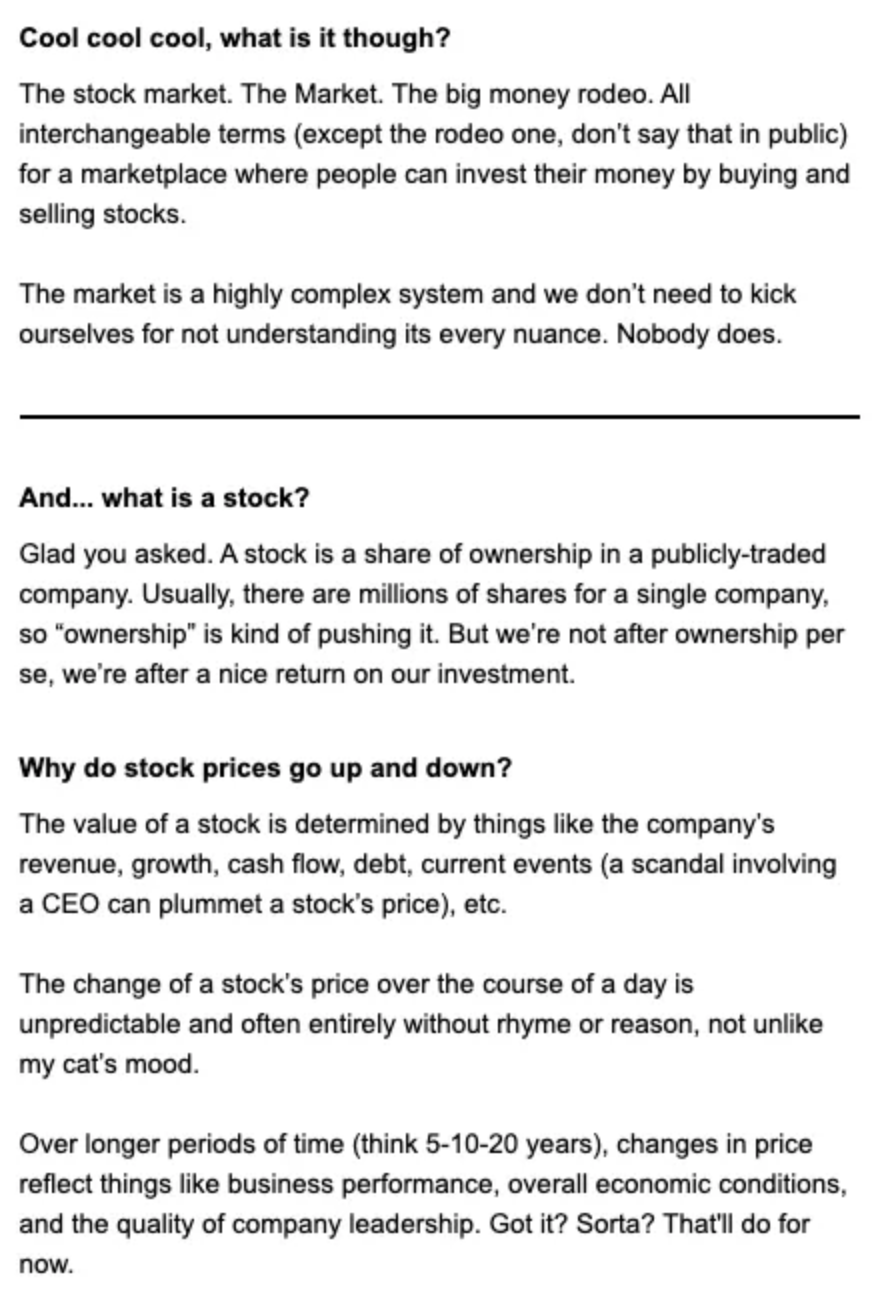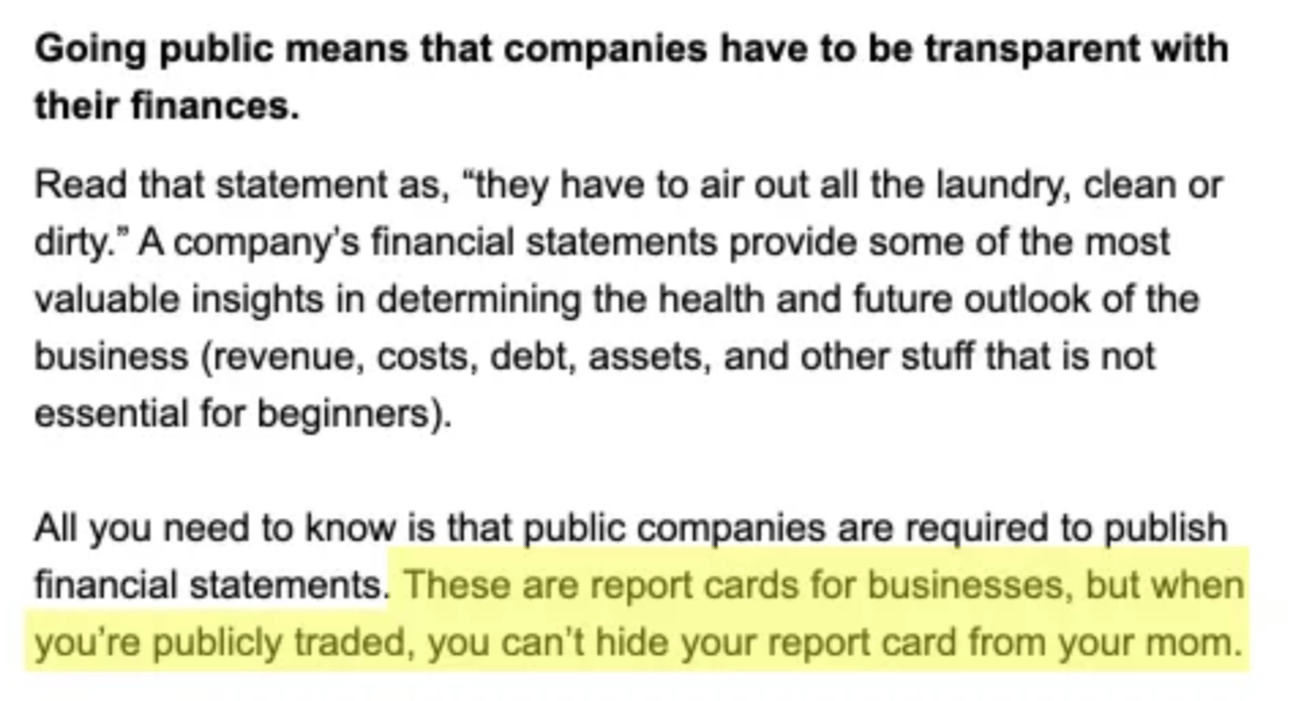|
|
Key Takeaways
- Developing your "voice" is a process that demands lots of writing and reading
- When I'm writing for EBCs, I try to use the Q&A format, metaphor, narrative (including a healthy dose of personal stories), and humor
- Be selective with humor — there's a fine line between additive and distracting
|
|
|
Good morning friends,
As I write this, it's got me reflecting a bit on my own journey as a copywriter. (even though I never would have called myself that)
ButI’ve been writing copy since I led marketing at The Knot and then wrote all the copy for House of Wise. Now I kinda do it for a living for myself and my Fractional CMO clients.
Great copy leads to connection.
Connection leads to sales.
|
|
|
Today we're talking about building voice and style into your writing
I do not claim to be a writing teacher.
But, from my own experience (a posteriori — as they say), there are some things I've picked up in the process of writing about 120k words for various email-based courses and another 80,000 words for my book!
Like yesterday, these fall within the realm of "tactics".
Developing and honing your voice doesn't happen overnight*, so give yourself some grace as you build out your course.
It doesn't really "happen"... it's just kind of always "happening".
|
|
|
|
What's so important about voice?
What's easier?
Conveying your personality over a live video stream... or in a series of emails?
Answer is obvious.
We are facing a "richness of medium" problem.
The more robust the medium, the easier it is to let your freak flag fly (and THAT is what people are really paying for).
Reading is pretty low on that totem pole unfortunately, so we gotta get crafty.
This is not an exhaustive list of techniques, but it includes some of my personal favorites. Fortunately, all of these methods can be deeply personalized (it's not "say this, then say that").
Alright, enough preamble, let's check 'em out.
|
|
|
|
For a conversational feel, utilize the Q&A format
I see Q&A a lot (just look up a few paragraphs to the bolded text).
What do I love about Q&A?
Well, you're forced to anticipate questions (and prioritize them!) and it evokes the sensation of learning (which keeps them coming back).
Here's an example:
|
 |
For a personal touch, tell stories!
This accomplishes two things: you scratch the brain's itch for ****narrative, and you get an opportunity to add a few layers to the student-teacher relationship.
People LOVE stories — it's evolutionary (it's also why we occasionally cry during Google commercials).
Yes, good storytelling is an art form.
But here's the thing: so long as the point of the story is clear and the emotions that you are conveying are coming from a real place, you'll be able to sufficiently channel your inner William Shakespeare (or Cormac McCarthy... whatever matches your vibe).
|
|
|
To add depth to understanding, incorporate metaphors and similes
I listened to a podcast on cognitive science and metaphor.
Do I remember the details of synaptic clefts and clusters?
No chance.
What stuck with me was one simple takeaway: metaphor deepens our understanding of something, it doesn't just paraphrase it.
Here's an example:
|
 |
As you'll notice from the example above, metaphor is also a great opportunity to incorporate humor. But eager humor-incorporators beware: it's a fine line between entertaining and adding value with humor... and distracting with it.
|
|
|
Laughter will keep your students coming back, but be selective with jokes!
"don't add humor, find it."
Think of a time when you were at a corporate event or public talk and someone tried to be funny. I'll bet the joke fell flat on its face. Trying to be funny over email is not a wise move. Trying to communicate clearly and then spending some time reflecting on the humor that is hiding in the content... that's a much better approach.
It's also why incorporating humor is one of the final stages of my personal writing process.
|
|
|
There you have it folks
Four tactics that you can employ right now to augment your voice-building efforts. Use the Q&A format to keep things conversational, employ metaphors to deep meaning and understanding, tell stories to get personal, and take the time and effort required to find the humor! I think you know what happens next...
If you said, "I've gotta re-write my email again, don't I?" you would be correct
Take what you've learned about the email outline, body copy structure, and now a few stylistic tools, and give that email a third pass.
You will hardly recognize the first draft when this is over.
In the next email, I'll be detailing my personal writing process.
After that, we're on to Chapter 4, which is all about building up your email automations for the optimal learning experience (skipping weekends? We can do that. Self-pacing?? We can do that too. Using survey tools and Zapier to read someone's goal back to them at the end of the course!? Anything is possible.)
TTFN!
Amanda
Fast forward: click the link to get the next email
|
 |
|
|